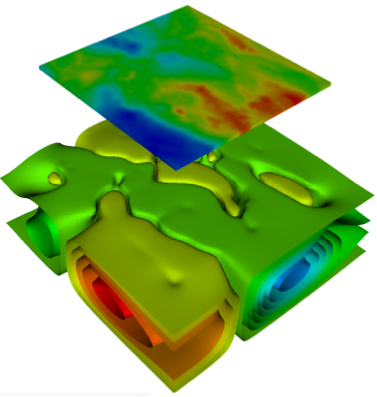Escript-downunder: Large-scale inversion on parallel computers
Summary
The downunder module provides a collection of high-level tools for 3D inversion of geophysical data using the finite element method. It follows an open design approach to give users easy ways to extend capabilities. The tool kit is based on the escript module for numerical modeling which, through its python-based user interface, provides a convenient high-level interface to build complex inversions and at the same time to make efficient use of desktop computers and HPC facilities with thousands of cores.

Figure 1. Results of a joint inversion of gravity and magnetic field anomaly data over a region of about 100km by 100km. The colours indicate the magnetic susceptibility variation to a depth of 30 km.

Figure 2. Inversion of gravity anomaly data. The contour plot of the inversion results (bottom) show the density anomalies in the subsurface (blue=negative, red=positive)
Features
Python-based user interface
Finite Element Method (FEM)
optimized for large data sets
Virtual Geophysics Laboratory (VGL) integration
gravity and magnetics
joint inversions with multiple data sets
extendable inversion capabilities
open design with symbolic computing
scalable performance with 8000+ processor cores
integration with advanced 3-D visualization
supported formats: netCDF, Silo, VTK, ER Mapper, ...
Open Source License
compatible with Linux, Mac, Windows
Download
The code can be downloaded from https://launchpad.net/escript-finley
License: Open Software Licence v 3.0
Publications
-
Gross Lutz , Kemp Carina (2013):
Large Scale Joint Inversion of Geophysical Data using the Finite Element Method in escript.
ASEG Extended Abstracts 2013 , 1–4.
Project funded by the Australian Geophysical Observatory System (AGOS), AuScope NCRIS, CRIS, NCRIS2.










